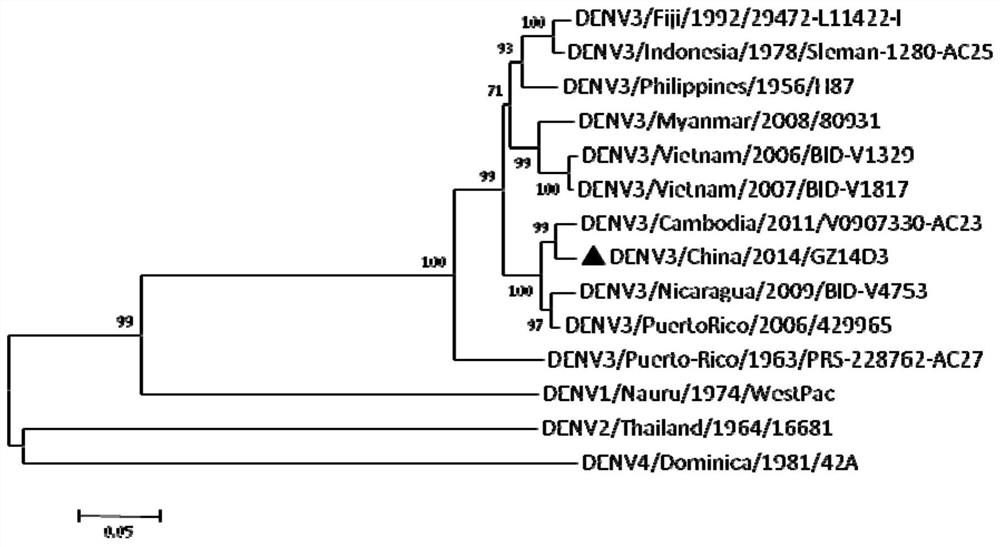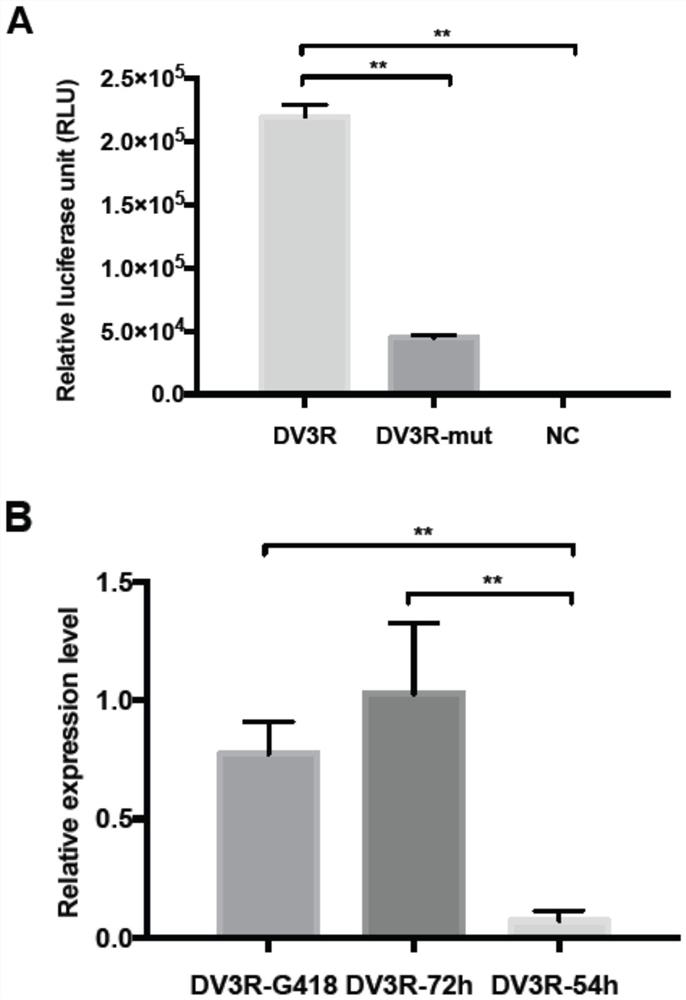Dengue virus serum type 3 epidemic strain GZ14D3 replicon and application thereof
A technology of dengue virus and replicons, applied in the field of genetic engineering
- Summary
- Abstract
- Description
- Claims
- Application Information
AI Technical Summary
Problems solved by technology
Method used
Image
Examples
Embodiment 1
[0050] Example 1 Phylogenetic tree of DENV-3 epidemic strain GZ14D3
[0051] First, inoculate clinical dengue virus samples on Vero cells for culture and amplification to obtain higher titer viruses, extract viral RNA, reverse to obtain cDNA, and amplify sequences covering most of the genome by PCR in three segments , Sequencing identification of strains. According to the Rico-Hesse dengue virus genotype nomenclature, we downloaded the E protein gene sequences of DENV-3 genotypes and representative strains of DENV1-4 from GenBank, and compared them with MEGA7 software, neighbor-joining (NJ) to build a phylogenetic tree. According to the phylogenetic tree, it can be seen that the epidemic strain ZG14D3 belongs to the dengue virus serotype III type, and the genotype belongs to the Indian subcontinent type ( figure 1 ).
Embodiment 2
[0052] Construction steps of embodiment 2 DENV-3 replicon
[0053] The vector we use is the pTight vector, which contains a high-copy origin of replication derived from pBR322, a seven-time tetracycline response element (7xTRE), a cytomegalovirus (CMVmin) eukaryotic promoter, 3'UTR, and the first 402 of the capsid protein Base sequence, renilla luciferase reporter gene (Gluc), FMDV2A protein cleavage sequence, neomycin resistance gene (Neo), EMCV IRES element, base sequence of the first 24 amino acids of E protein, the entire nonstructural protein sequence, the 3'UTR of DENV-2 16681, the antigenome sequence of hepatitis delta virus ribozyme (HDVr), and the polyadenylation signal sequence of Simian Virus 40 (SV40). When constructing the replicon, the method of homologous recombination was adopted. Since the 3'UTR of this strain was cloned into the vector, there was a deletion phenomenon, so the 3'UTR of the DENV-2-16681 strain was used to replace it, and finally a chimeric DEN...
Embodiment 3
[0054] Example 3 DENV-3 replicon effectively replicates in cells
[0055] The replicon plasmid was transfected into BHK-21 cells and screened with neomycin, and the DENV-3 monoclonal replicon cells containing stable expression of high luciferase reporter gene signal were screened out after 3 weeks ( image 3 ).
[0056] Extract the RNA of the replicon cells that have been continuously passaged for 120 days, and sequence and analyze the DENV-3 RNA sequence. It is found that there are 3 synonymous mutations in NS2B, NS3 and NS5 respectively (Table 1), and the luciferase activity of the replicon during passage has remained at a high and stable level.
[0057] Table 1 The sequence of the RNA extracted from the BHK-21 replicon cells of 120 days of continuous passage and analyzed by reverse sequencing
[0058]
[0059]
PUM
 Login to View More
Login to View More Abstract
Description
Claims
Application Information
 Login to View More
Login to View More - R&D
- Intellectual Property
- Life Sciences
- Materials
- Tech Scout
- Unparalleled Data Quality
- Higher Quality Content
- 60% Fewer Hallucinations
Browse by: Latest US Patents, China's latest patents, Technical Efficacy Thesaurus, Application Domain, Technology Topic, Popular Technical Reports.
© 2025 PatSnap. All rights reserved.Legal|Privacy policy|Modern Slavery Act Transparency Statement|Sitemap|About US| Contact US: help@patsnap.com



